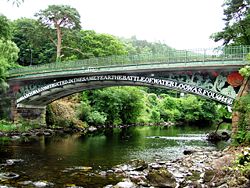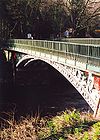Waterloo Bridge (Caernarfonshire)
| Waterloo Bridge | |||||
| Location Map ( geo) | |||||
 | |||||
| |||||
| From: | Bangor | ||||
| To: | Betws-y-Coed | ||||
| County | |||||
| Caernarfonshire | |||||
| Highway Authority | |||||
| Welsh Government | |||||
| Opening Date | |||||
| 1815 | |||||
| Additional Information | |||||
| |||||
| On road(s) | |||||
| A5 | |||||
Waterloo Bridge spans the River Conwy in Betws-y-Coed, Caernarfonshire is one of the earliest iron bridges in the world. It was built to a design by Thomas Telford and erected in 1815, although not completed until the following year. The date of the bridge is clear to anyone who visits or uses the bridge, as the legend 'THIS ARCH WAS CONSTRUCTED IN THE SAME YEAR THE BATTLE OF WATERLOO WAS FOUGHT' (with full-stops used to identify spaces) is cast in large letters on the arch ring below the deck. The ironwork was cast at William Hazeldines foundry, which Telford used for most of his iron bridges The bridge was built as part of Telford's road from London to Holyhead, and still carries the A5, the number assigned to this route in 1922. Despite being in the heart of rural North Wales, where today the Welsh identity is strongly upheld, the four spandrels of the bridge feature all four national symbols - the English rose, Scottish thistle, Welsh leek and Irish shamrock.
The bridge has a single shallow arched span across the river between stone abutments. The ironwork below the deck is still the original, with the main structure painted green, the four national symbols picked out in red and the lettering in white. The deck has, however, been replaced at least twice. It was first widened in 1923 when the central iron ribs were encased in concrete to add strength and a new concrete deck was laid over the top, providing cantilevered pavements either side of the road. The deck was replaced again in 1978 by a thicker and slightly wider deck, able to carry the increased loads of modern traffic. At this time the stone abutments were also strengthened. There is a double line of metal railings along each side of the bridge acting as parapets.
Junction
At the eastern end of the bridge, the A5 curves round to the right as it meets the A470, which has travelled south down the Conwy Valley. The junction is a simple T junction with a central turning lane for traffic turning right into the A470. The two routes then enjoy a short multiplex south, before the A470 turns off once more, at another T junction with a very narrow turning lane for traffic turning right onto the A470. The A5 maintains priority throughout, despite the sharp curve off the bridge.
Routes
| Route | To | Notes |
| Bangor, Capel Curig | ||
| Llangollen | ||
| Conwy, Llanrwst | ||
| Dolgellau, Blaenau Ffestiniog |
| Waterloo Bridge (Caernarfonshire) | ||
|


